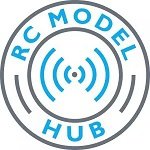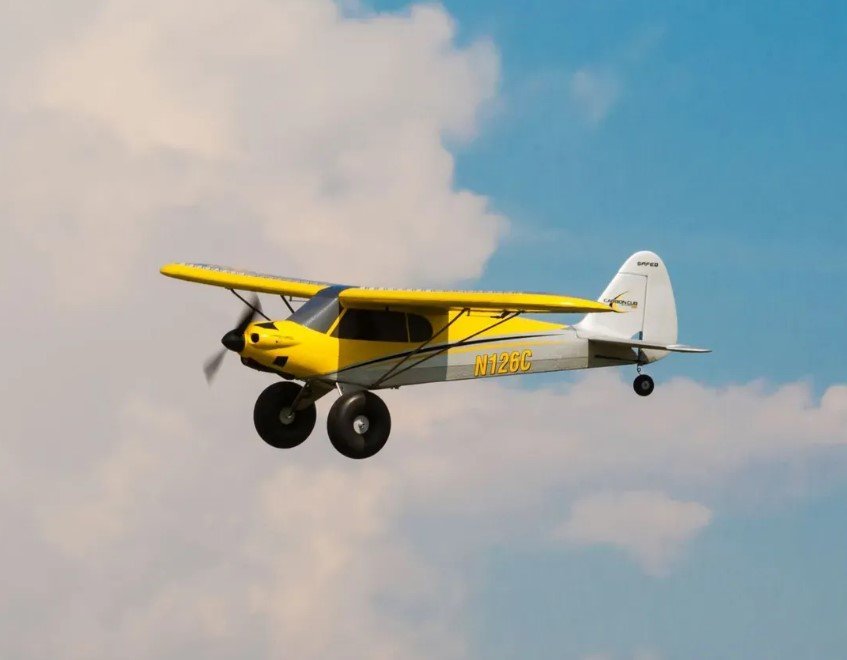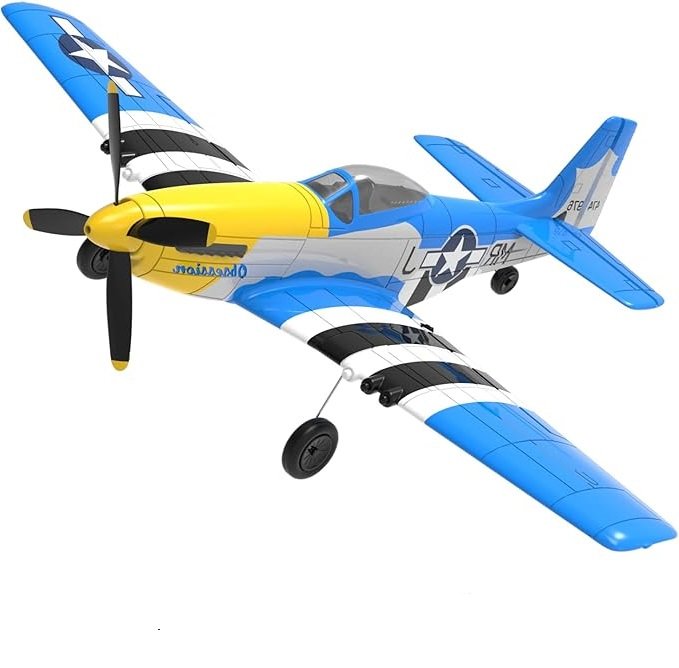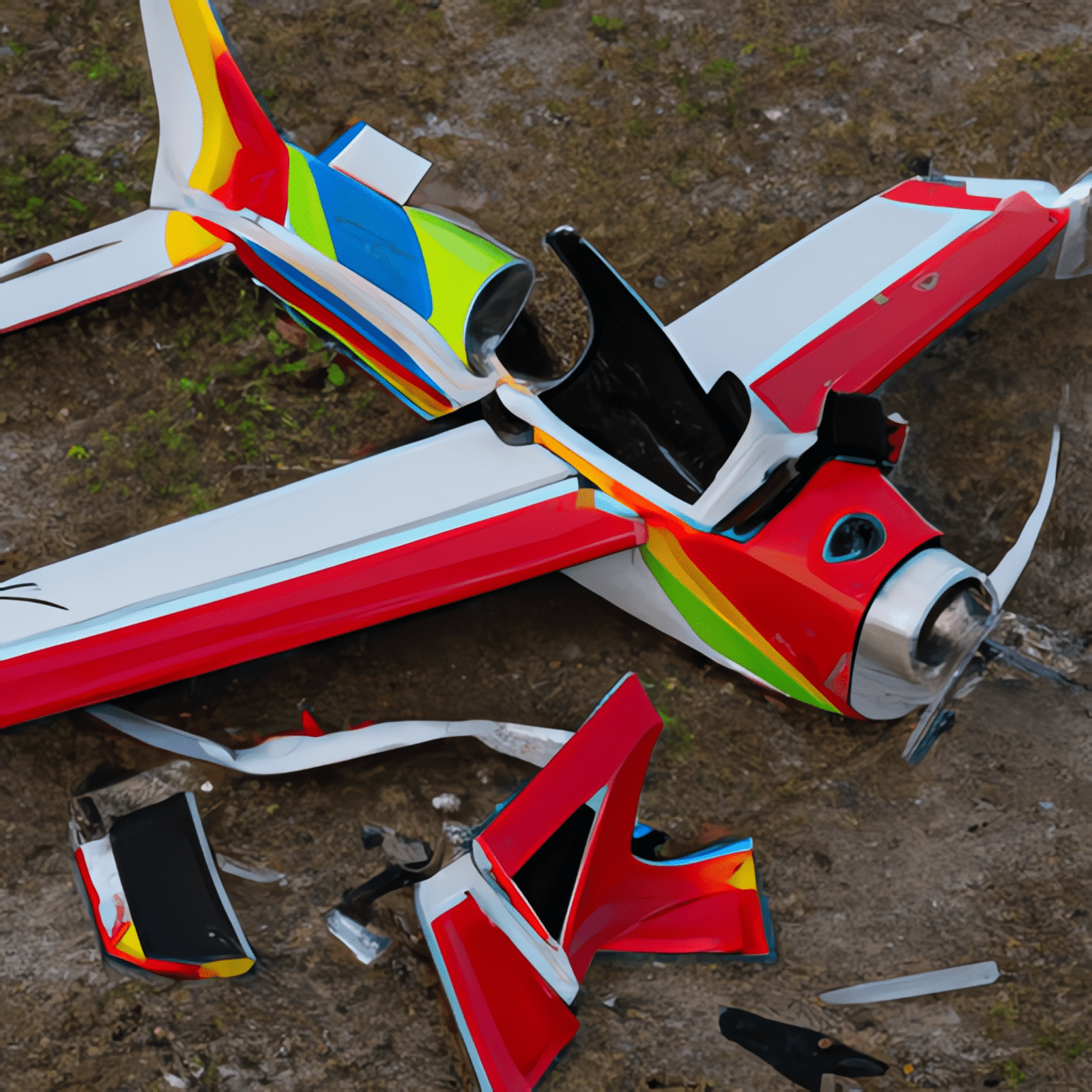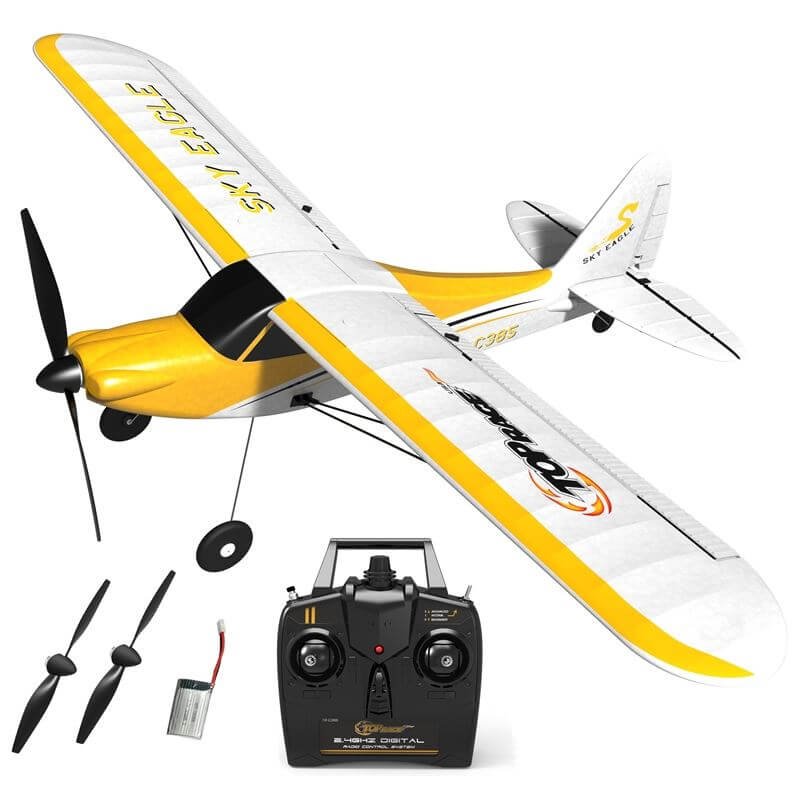Any links on this page that lead to products on Amazon, the Ebay Partner Network (EPN) and other companies may be affiliate links and we earn a commission if you make a qualifying purchase. Thanks in advance for your support!
So you’re curious about flying RC airplanes, and whether you’d master the skills needed and even enjoy the experience? Your best bet is to give it a try with a model that makes it easy and fun at the same time. We’ve taken our own and others’ experiences and come up with a shortlist – and one popular recommendation – that will make choosing one a breeze.
Read on below to find out all about RC trainer planes.
Our Pick of the Best RC Trainer Planes
We’ve reviewed a host of RC trainer planes, and come up with a shortlist of models, any of which we’d be pleased to have as a first or even intermediate RC trainer. They’re set out in the table below, but we’ve given more detail, together with some videos, further down the page.
If we had to choose which, we’d probably go with one of the 4 Channel RC trainers – either the Top Race or VolantexRC. If you have a bit more cash to spend, the E-flite RC Airplane Apprentice STS would definitely be the one, as it is a good size, has a great reputation, and you can even get floats for it!
| Image | Product | Features | Price |
|---|---|---|---|
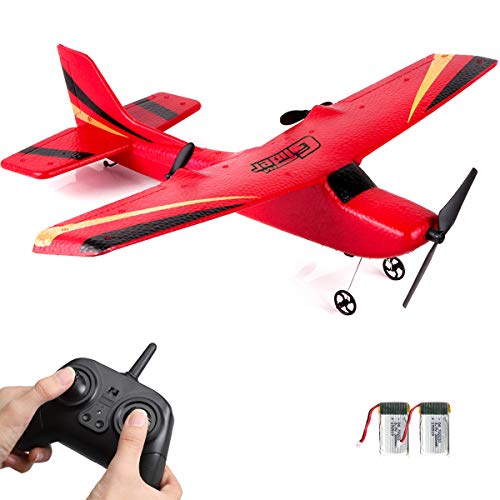 |
| Check details on Amazon (US)Check details on Amazon (UK)Check details on Ebay | |
 |
| Check details on Amazon (US)Check details on Amazon (UK)Check details on Ebay | |
 |
| Check details on Amazon (US)Check details on Amazon (UK)Check details on Ebay | |
 |
| Check details on AmazonCheck details on Ebay | |
 |
| Check details on Amazon (US)Check details on Amazon (UK) |
If you’d like to find out more about beginner RC planes. we’ve done another article over here. If you’re into building your own, you’ll need a kit as a beginner. We’ve looked at the best over here.
RC Trainer Videos
HAWK’S Work 2 CH RC Airplane
Check out some more detail on this plane over at our post HAWK’S Work 2 CH RC Airplane – Perfect Starter Model?
Top Race RC Plane 3 Channel
Find out more at Top Race RC Plane: Durable, Fun, and Easy to Fly.
Top Race RC Plane 4 Channel
More detai over at our post Top Race RC Plane TR-C385 Review: Stunt Flying Delight.
VOLANTEXRC RC Airplane 4CH
E-flite RC Airplane Apprentice STS
What is an RC Trainer Plane?
An RC trainer plane is a model aircraft specifically designed as a beginner RC plane to learn and develop remote control flying skills.
These planes are equipped with features and technologies that make them easier to control and provide a stable and forgiving flying experience. They are typically designed with a high wing configuration, light wing loading, and stable flight characteristics, all of which contribute to their ease of control and stability in the air.
RC trainer planes often have built-in gyro stabilizers and beginner-friendly flight modes that help new pilots learn to fly confidently and safely. With their simple controls and safe technologies, RC trainer planes allow beginners to gradually build their skills and confidence before moving on to more advanced and faster aircraft.
Read on to find out more about these, and why they’re the best place to start your RC flying experience!
Benefits of RC Trainer Planes for Beginner Pilots
RC trainer planes are the ideal choice for beginner pilots who are just starting their RC journey. These planes are specifically designed to provide a safe and easy flying experience, making them perfect for first-time modelers.
- Slow Flying
One of the key benefits of RC trainer planes is their slow flying speed. This allows beginners to have extra time to react and make corrections, helping them build their confidence and skills gradually. Additionally, these planes are designed to automatically return to level flight if control is lost, preventing crashes and minimizing the risk of damage.
- Durability
Durability is another advantage of RC trainer planes. They are built to withstand crashes and rough landings, ensuring that beginners can learn from their mistakes without constantly worrying about damaging their aircraft.
- Easy To Assemble and Control
Furthermore, these planes are easy to assemble and control, making the learning process less intimidating for new pilots.
- Low Cost
Finally, RC trainer planes usually cost less to buy and run than more sophisticated models.
In summary, RC trainer planes offer a range of benefits for beginner pilots. With their slow flying speed, ability to return to level flight, durability, ease of control, and low cost these planes provide an affordable, safe, and enjoyable learning experience for those who are just starting out in the world of remote control aviation.
Types of RC Trainer Planes
When it comes to choosing the best RC trainer plane, there are a variety of options to consider. One common offering is the 3 or 4-channel RC plane, which allows for greater control and maneuverability. Another consideration is whether to opt for an electric or gasoline-powered model, with electric planes often being more beginner-friendly due to their simpler operation and lower maintenance requirements.
In terms of wing configuration, planes with a high wing placement and light wing loading are often recommended for beginners as they provide more stability and easier control. Additionally, some models feature gyro stabilizers or flight modes that provide assistance with leveling the aircraft and preventing common bad habits.
Ultimately, the choice of RC trainer plane will depend on personal preference and skill level, but considering factors such as wing design, motor type, and available flight modes can help ensure a successful and enjoyable flying experience.
3-Channel RC Plane
When it comes to RC planes, beginners often find themselves overwhelmed by the different types and controls available. One of the best options for beginner RC pilots is a 3-channel RC plane.
Unlike the 2-channel planes that only have throttle and rudder controls, a 3-channel RC plane adds elevator control, which greatly enhances the maneuverability of the aircraft. With elevators, pilots can control the pitch (up and down) of the plane, making aerobatics possible.
While more advanced pilots may prefer the challenge of a 6-channel plane, a 3-channel plane provides a great balance between simplicity and control. It allows beginners to learn the basics of flight and gain confidence before moving on to more advanced maneuvers.
The added maneuverability of a 3-channel plane also allows for more enjoyable flying experiences. Pilots can perform aerobatics with ease. This makes flying a 3-channel RC plane more fun and exciting, even for experienced flyers.
Overall, a 3-channel RC plane is a good choice for beginner pilots who want to learn the basics of flight while still having the ability to perform a variety of maneuvers. Its simplicity, maneuverability, and balance make it a great option for any skill level.
4-Channel RC Plane
The 4-channel RC plane is the go-to choice for both novice and experienced pilots looking for more control and maneuverability. Unlike the 3-channel and 2-channel planes, the 4-channel RC plane offers additional controls that can take your flying experience to new heights.
One of the main advantages of the 4-channel RC plane is the inclusion of ailerons. These small control surfaces, located on the wings, enable the pilot to bank the plane left or right, allowing for more precise and dynamic turns. This feature adds a new level of excitement and realism to the flying experience.
Experienced pilots will appreciate the added challenge and skill required to operate a 4-channel RC plane. With more controls to manage, including elevator, aileron, rudder, and throttle, flying a 4-channel plane requires a higher level of focus and coordination. The ability to perform complex maneuvers and aerobatics provides a thrilling experience for those seeking a new challenge.
Additionally, the 4-channel RC plane offers more versatility when it comes to flight patterns and tricks. Pilots can experiment with different flying styles, including inverted flight, loops, rolls, and more, making each flight a truly exhilarating experience.
For experienced pilots looking to take their RC plane skills to the next level, the 4-channel RC plane is an excellent choice. With its additional controls and increased maneuverability, this plane offers a fun and rewarding flying experience for those seeking a new challenge. So, strap in and get ready to take flight with the 4-channel RC plane!
Electric Airplane
Electric airplanes are a popular choice for both beginner pilots and experienced flyers. One of the biggest advantages of electric planes is that they are cleaner and easier to handle compared to internal combustion engine (IC) planes. Instead of dealing with messy fuel and engine maintenance, all you need to do is charge the batteries between each flight.
Whether you’re a beginner or a seasoned pilot, electric airplanes offer a wide range of options to suit your needs. With advancements in battery technology, flight times have significantly improved, allowing for longer flights. Additionally, many electric airplanes come equipped with safe technology features such as gyro stabilizers, beginner modes, and virtual fences to help beginner pilots learn to fly with ease.
Ready To Fly (RTF)
Ready to Fly (RTF) planes are perfect for complete beginners as they come out of the box fully assembled and ready to take to the skies. They are often supplied with transmitter and batteries, plus charger, so you can literally take them out of the box and start flying.
In practice, a lot of RTF models require a minimal amount of assembly, such as attaching the wings, but it’s very little work and technical knowledge.
Almost Ready to Fly (ARF) planes require some assembly, but they offer more customization options. Bind and Fly (BNF) planes are a great choice for pilots who already have a compatible transmitter. Lastly, kit models allow experienced pilots to build their planes from scratch, adding a personal touch to their flying experience.
Skill Level Considerations
When it comes to choosing a trainer plane for remote control (RC) flying, considering your skill level is important. Different planes cater to different proficiency levels, from complete beginners to experienced flyers.
Beginner planes are designed with technology and features to assist novice pilots in learning the basics of flight. These planes often have beginner modes to help prevent crashes and ensure a smooth learning experience, intermediate planes that are suitable for pilots who have mastered the fundamentals, and advanced modes for more challenging maneuvers.
Experienced pilots can opt for high-performance planes with advanced features and capabilities to match their skill level. All in all, selecting a trainer plane that aligns with the pilot’s skill level is crucial for a rewarding and successful RC flying journey.
What is “SAFE” Technology?
SAFE (Sensor Assisted Flight Envelope) is a gyro-stabilizer technology that has been developed by Horizon Hobby to assist RC pilots in controlling their models.
Gyro stabilizer tech is a game-changer for complete beginners looking to start their RC plane journey. This innovative system offers a range of features and benefits that make flying easier and safer, even for those with no prior experience.
One of the standout features of this tech is its ability to limit the actions of novice pilots, ensuring stability and preventing accidents. This is achieved through a combination of gyro stabilization and flight envelope protection.
Essentially, the system assists the pilot in maintaining level flight and prevents the plane from entering dangerous flight configurations, as well as limiting its range to prevent loss. It often has a return home button in the event complete control is lost.
The level of assistance it provides is customizable to suit the pilot’s skill level. Different options and settings allow beginners to gradually increase their level of control as they gain confidence and experience. This ensures that the transition from beginner-friendly flight characteristics to more advanced piloting techniques is smooth and manageable.
Manufacturers have developed their own versions of the stabilization software. Horizon Hobby incorporated SAFE as well as AS3X (Autostabilization) into many of their models, VolentexRC calls it Xpilot, and Top Race RC has its 6-Axis Gyro System.
Whether you’re a beginner looking to start your RC plane journey or an experienced pilot wanting to introduce someone new to the hobby, stabilization technology is an essential feature to consider.
Pre-flight Preparation and Setup Checklist
Pre-flight preparation and setup are crucial for a successful flight when it comes to an RC trainer plane. Follow this checklist to ensure a safe and enjoyable experience:
1. Inspect the airplane fuselage: Check for any cracks, loose fittings, or damaged components. Ensure that everything is securely fastened.
2. Examine the wings: Check the wing structure, ensuring there are no bends, warps, or broken parts. Confirm that the wing attachment is secure.
3. Inspect the operating surfaces: Check the ailerons, elevator, and rudder for proper movement. Confirm that the control linkages are tight and functional.
4. Check the motor and propeller: Ensure that the motor is securely fastened. Inspect the propeller for any damages or loose fittings.
5. Inspect the landing gear: Check for any damage or wear. Ensure that it is securely mounted and aligned.
6. Check the batteries: Verify that the flight battery is fully charged. Inspect for any damages or signs of wear. Also, ensure that the transmitter batteries have sufficient power.
7. Inspect the receiver with servos: Verify that the receiver and servos are securely mounted. Ensure that all connections are secure and free from any damage.
8. Test the transmitter: Ensure that the transmitter is fully charged and functional. Check that all controls are working smoothly.
By following this pre-flight preparation and setup checklist, you can confidently take your RC trainer plane to the skies. Remember, safety should always be a priority for both beginner and experienced flyers.
Flying Basics for Beginner Pilots
When it comes to flying a remote control (RC) plane, beginner pilots need to start with the basics. Understanding the key concepts and techniques is crucial for a successful flight. Let’s dive into the flying basics that every beginner pilot should know.
Throttle control is an essential skill to master. It allows pilots to increase or decrease the power of the engine. Controlling the throttle will determine the speed and altitude of the plane. Elevator control is responsible for adjusting the pitch or the angle of the plane’s nose. By moving the elevator control, pilots can make the plane climb or descend.
Rudder control is used to control the yaw of the plane. It helps in changing the direction of the plane. Aileron control, on the other hand, helps in banking the plane to the left or right. This allows for smooth turns and maneuvers.
Practicing these controls in a safe and open area is recommended for beginner pilots. Understanding how each control affects the plane’s movement is essential for mastering flight maneuvers.
By familiarizing themselves with the throttle, elevator, rudder, and aileron controls, beginner pilots can confidently navigate their RC planes. With practice, they can improve their skills and eventually move on to more advanced maneuvers.
Finding the Right RC Trainer Plane
Finding the right RC trainer plane is crucial for beginners who are just starting their remote control flying journey.
Ideally, these beginner planes should come RTF (ready to fly) out of the box, with little assembly required, and all the components needed, including transmitter, receivers, batteries, and charger.
RC Trainer airplanes will tend to have a high wing configuration, which provides better stability and easier control.
It is also important for these planes to be made of a resilient material, like foam, which allows for easy reconstruction or replacement of components in case of accidents. Incorporating flight stability gear, such as SAFE technology, further ensures a smooth and safe flight experience.
Additionally, these planes should have an electric motor driving a propeller and no more than 3 or 4 channel controls, allowing beginners to learn the basics without feeling overwhelmed.
Opting for trainer planes from well-known manufacturers is advisable, as it ensures the availability of spare parts and reliable after-sales service.
Lastly, having a spare battery or two is highly recommended to increase flight times and minimize downtime.
For our pick of the best, take a look at the table above.
